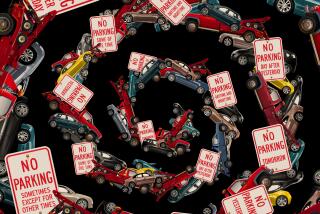Winding Through the Auto Repair Maze
The case was extreme but not unusual. When their car sputtered and died recently, a couple had it towed to a reputable repair shop. The carburetor was cleaned; still it sputtered on the drive home and died.
Over the next two weeks, a broken hose was replaced, the gas tank cleaned out and a new fuel pump put in, twice. Each time, theyâd either drive off and have to call a tow when it died, or come in to pick it up, supposedly fixed, and be unable to drive it away.
The most common complaint about repair shops is that the vehicle wasnât repaired. Maybe the owner went in for a tuneup, says John Waraas, chief of Californiaâs Bureau of Automotive Repair, âand spent X dollars, and in a couple of days, the car starts to miss again.â Maybe he âtook it in for four problems,â says Ed Lindsay, assistant manager of the garage approval program at the Automobile Club of Southern California, âand they only looked at three.â
Itâs a difficult relationship, fraught with problems. The average consumer approaches it in total ignorance, enters it in total dependence and reacts to it in total frustration.
Itâs worse than ever now. Consumers are increasingly ignorant: Teen-age boys used to tinker with cars in their back yards, but recent generations have fewer back yards and more distractions. Garages are different. âYou always took the car to Sam at the corner garage because he knew your car,â says Richard Hebert, AAA spokesman in Washington. If thereâs still a station there, it probably sells only gas, tires, batteries, bread and milk. Consumers go now to big specialists, talking with a service manager (often on commission) and never the person who works on the car.
Even cars are different, so complex, so computerized that âyou canât take it out in your back yard,â says Hebert. Service is expensive--no longer $50, but hundreds for a checkup and oil change. Many therefore skimp on proper maintenance.
There may, however, be help available, before, during and after the experience. Before, it helps to know something about cars, which few do, never having been teen-age tinkerers. Car people recommend reading the ownerâs manual, as if it were really reading matter, explaining the engine as well as the dashboard.
Those unable to evaluate the work had better choose facilities wisely. Depending on the state, licensure may mean something: Californiaâs bureau, considered particularly consumer-protective, âregistersâ virtually all applicants but investigates any indications of malfeasance. Last year, it issued 2,800 citations, revoking 25 registrations.
Shops displaying an âASE Certifiedâ seal employ at least one of 250,000 technicians nationwide with two years experience and enough knowledge to pass the tests of the nonprofit, industry-supported National Institute for Automotive Service Excellence in Herndon, Va. But the seal may refer to a single employee, who hardly works on all cars, and it certifies only competence. âItâs not an end-all, and there are good people out there who arenât certified,â says ASE spokesman Richard White, âbut itâs a yardstick by which to measure the shop.â
So is AAA âgarage approvalâ-- the nationwide program offered by 39 local clubs in 26 states, with 4,500 approved repair shops, or the independent programs of the California clubs. The shops get potential business; consumers get a guarantee that at the very least, says Hebert, âsomebody has looked at this shop.â
They examine its insurance, financial stability and workersâ experience, thoroughly inspect facilities and equipment, and contact several hundred past customers for their opinions. The Southern California club (which approves 900 facilities) requires an 85% positive response to the survey, making it, says Lindsay, âthe No. 1 reason for turning down approval.â
The consumer even has some protections during the encounter. Everyone recommends (California, for one, requires) that repair shops provide written estimates and get consent for any changes mid-service. Really anxious people can also demand to see any parts removed to be sure they were truly replaced and that they needed to be.
They might also pay by credit card, as with any purchase generating anxiety. Under federal law, and with certain geographic and financial restrictions, cardholders who couldnât resolve the dispute with the vendor may be able to dispute the charges on grounds of poor quality when the charge comes in. The card issuer must charge back the amount and investigate the case. Auto repairs already constitute one of MasterCardâs five most frequent disputes.
People most desperately want help after an unsatisfactory repair, of course. The AAA-approved shops must guarantee their work for members, and the clubs stand behind it. But the amount of mediation offered is variable, and the results of a final arbitration unpredictable. Some club officials at some locations may get involved while a vehicle is in the shop; others may insist on a written complaint.
Such variability is probably universal. Anyone who calls the California Automotive Repair Bureauâs statewide toll-free number, and gets through (as 155,000 did last year), gets information on law or procedure, and if needed, a mailed-out complaint form to be mailed back for referral to a district office. Anyone calling a district office directly may get more immediate help or intervention, no help at all or no answer.
The bureau takes two weeks to three months to handle complaints. But last year, it received and investigated 46,935, negotiating $3.8 million âin adjustments, rework and refunds.â
None of these aids is a sure thing, all situations being different. But all provide another level of judgment, a mediator, maybe an ally. They may increase the possibilities for solution.
Maybe. Take the couple above. After thirteen days and five separate repairs, their car finally runs. They think that âyou have to trust peopleâs sincerity,â and that if theyâd sought outside help, the repairman, offended, would have quit trying.
Moral: Thereâs no sure advice on how best to handle these things.






